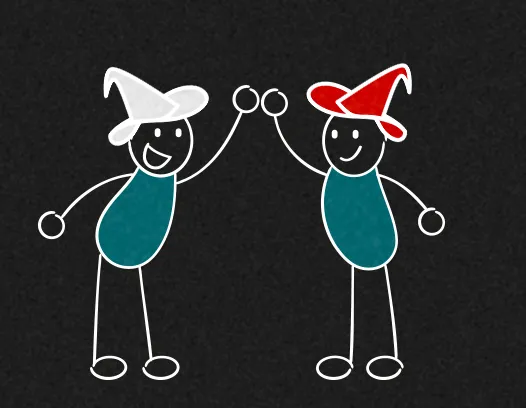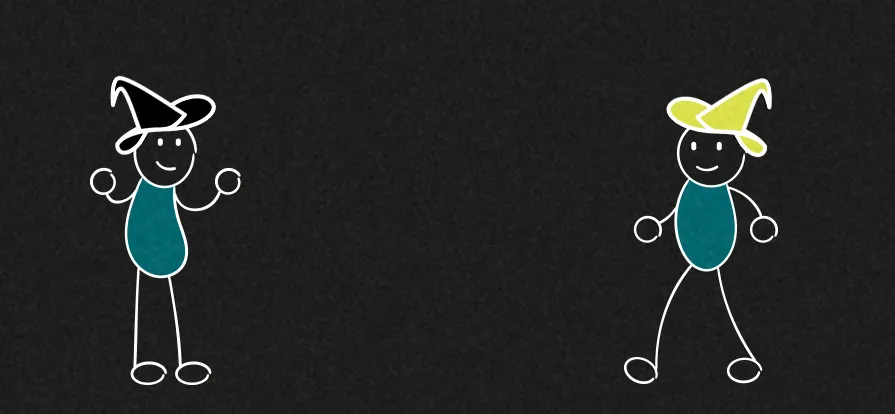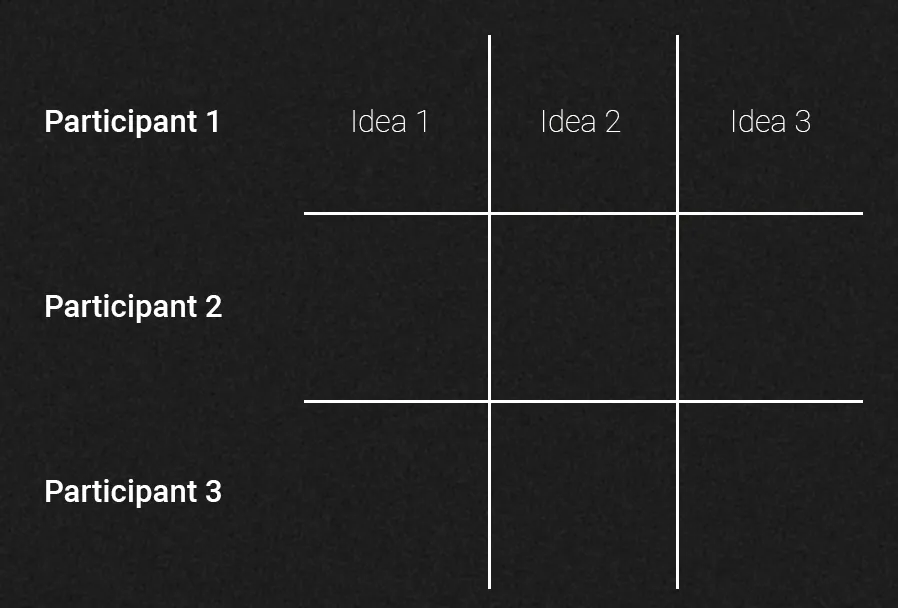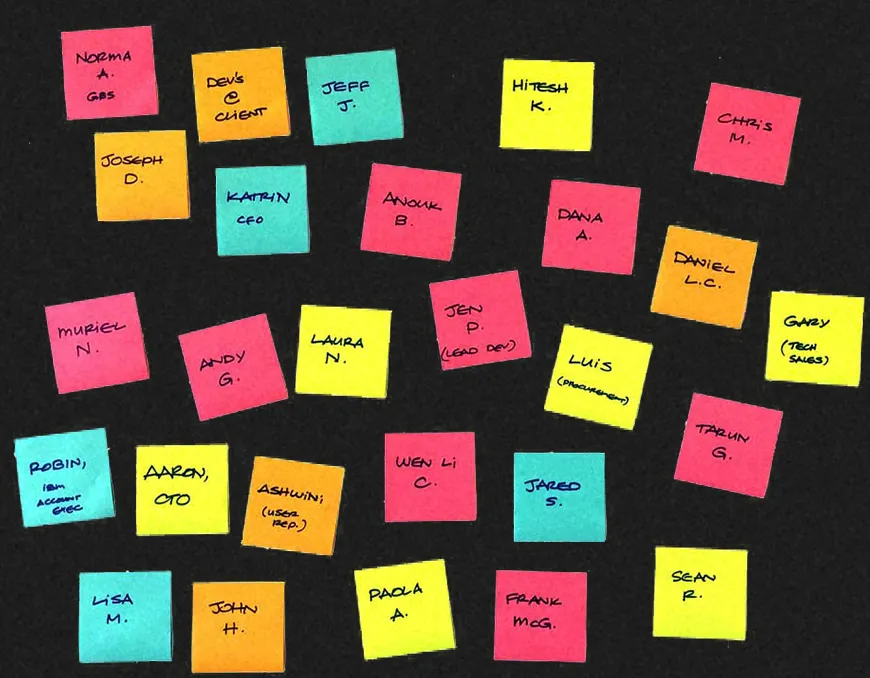
After all the understanding of customers’ pain points, needs, touchpoints and their journey, it’s time to get into exploring the possible solutions with different brainstorming techniques with exploring our creative confidence.
We will explore 3 different techniques for brainstorming,
- 6 Hats Brainstorming
- Grid Brainstorming
- Post-It Brainstorming
6 Hats Brainstorming
This technique is based on parallel thinking to help group discussions and promote more effective decision making. It helps to think from different angles, to evaluate the idea properly before implementing it.
What —
6 hats thinking is collaborative idea evaluating technique, to check the validity of an idea from 6 different perspectives. The technique promotes the divergent way of thinking to make impactful decisions and solve complex problems.
In a meeting, this technique challenges the participants to think in a 6 distinct directions or thinking roles. Each coloured hat represents a different role and when wearing it, a person has to adopt and think as per the characteristics attached to a particular hat.
White Hat represents to collect and present data, facts, stats, relevant information about the problem you are working to solve.
- Neutral and objective view
- What information is needed, how it might be obtained?

Red Hat represents thinking form heart, acknowledge feeling like, fears, likes, dislikes, loves, and hates.
- Does this make me angry/happy/excited/nervous/annoyed?
- How will the customer react to this?
- What my gut feeling says?
Black Hat represents acting as a devil’s advocate. To spot difficulties with intent to overcome risks.
- What are the possible threats?
- Is this real and can I trust this?
- What are the weaknesses in plan?

Yellow Hat symbolizes optimism. It finds the value and benefits of ideas and supporting concepts.
- Focus on, what’s good, advantageous, positive?
- How and why this idea work?
- How will this help our customers?
Green Hat focuses on creativity, new innovative ideas, new possibilities, to solve the problem.
- Out of box thinking
- What are the alternative available to solve the problem?
- What is holding our team back?
- How ca we work this out?

Blue Hat manages and leads the thinking process ensuring the guidelines are observed properly.
What is the purpose of this session?
How do we approach this problem?
Which solution is better for this problem?
Let’s understand the process with an example…
Finding a solution for wrong deliveries —
Wrong deliveries happen because the orders are received through phone calls and it requires manual efforts. Sometimes this results in wrong entries. the idea is to forbid orders through phone calls!
The person who wears the blue hat facilitates the activity. The blue hat explains the goal and instructs that they will discuss this problem for two hours, and kicks off the discussion…
With the White Hat, team presents factual information, e.g.:
- 75% of orders come from online platforms and only 25% form phone calls.
- 90% of our customer will adopt the change and 10% will stop working with us.
- There will be approx. 2% (around $40K) loss in sales.
With the Yellow Hat, the team will present the positive points and opportunities, e.g.:
- Saves 3 hours of manual effort
- Receives less customer complaints
- Customer satisfaction will increase
- Saves $50K or more from returns and chargebacks
With the Black Hat, the team will present the risks, threats, weaknesses, e.g.:
- Risk of losing loyal customers
- We need more budget to broadcast the change to people
- Affect the reputation of the company
With the Green Hat, the team will come up with the new innovative ideas to solve the problem, e.g.:
- Losing $40K in sales but saving $50K chargebacks equals $10K saving for broadcasting
- Can make video tutorials to teach people how to order online in more user effective and easy way with interactive learning.
Again, the Blue Hat, the team will converge the whole discussion. The team evaluated the idea of dropping the phone call order system and concluded that it will be beneficial for them.
General guidelines to use 6 Hats approach,
- Use Blue hat at starting and end point.
- It is not necessary to use all the hats. E.g.: Red hat is not used in above example.
- There is no specific sequence of hats, arrange them as per your requirement.
- The blue is usually worn by the team leader but not necessary.
This activity will help you think broader to design a great customer experience.
Grid Brainstorming
(Combining ideas to innovate better)
Grid brainstorming approach is another effective approach for generate ideas in the short span of time.
Preparation:
Few pens and grid papers for each participants (See the image 4 for reference)

Steps to follow: (For 3 participants)
- Sit together and properly understand the problem first.
- Name each participants (e.g.: A, B & C) in the grid as shown in image 4.
- Distribute the “Grid paper” and tell each participants to come up with 3 ideas in 5 minutes and to note down in a row against their name.
- Rotate the sheet,
In round one,
- First participant (A) will write the idea and pass his sheet to B; similarly, B & C will do the same.
In round two,
- A with C’s sheet, will improve the idea of C and passes to B; similarly, B & C will do the same.
In round three,
- A with B’s sheet will improve the idea of C on B’s sheet and returns in to B; similarly, B & C will do the same.
- All participants will get their respective sheet with the idea improvise by all other participants.

5. Idea evolution
This is where the magic happens. When we look into other ideas, it spontaneously triggers our thought process too. While rotating sheets, each participant has to add new thoughts to improve the idea written by the other participants.
E.g.: After the first round, participants A receives the the sheet from C, A will have to add his new thoughts to the ideas that will support and improve existing ideas of C.
6. After third round, the grid papers will be completely filled. Now each participant with his sheet has to vote for the best idea column, evolved through the process.
Example:
A bicycle company facing a sharp decline in sales of kids bicycle segment. What to do to solve this problem?
- Participant A writes, “ We can launch a new attractive model, specially designed for kids. We can use bright colours and kids characters in the design.
- Participant B adds to that, “ That’s a great idea, as Christmas is near it will be beneficial for us. We an launch it before 2 months so that people can buy early as a gift for kids.”
- Participant C adds, “So, we should create a broadcast like, “Christmas special sale for new kids bicycle with 10% special holiday discount.”
Post-It Brainstorming
Post-it brainstorming is very effective and one of the widely used approach to generate ideas in structured way.

Steps —
- Brain Dumping
This is the phase where you start thinking about the potential solutions while keeping these questions in mind and be prepared to dump everything you can think of in a post-it,- What is our objective?
- What are we solving?
- What do we want to achieve?
- Brain Writing
This is the phase where every team member will write the idea on the post-its. The idea is to diverge the possibilities, the scope for solving the problem.- Remember! put just one idea on one Post-it. One Idea, One Thought, One Point.
- Don’t analyze, don’t judge, don’t worry about the spelling and accuracy of sketch. Just note down.
- Brain Walking
Here, team members exchange ideas and converge to find the best ideas out of all.- At the same point, we will reach a good amount of ideas to work on.
- We need to use “Post-It voting” for converging those ideas, where they are evaluated, compared, ranked clustered and even removed.
- Participants vote by using stickers or simply using a marker to make a dot on the ideas they like.
By doing this, the team will have some of the best ideas to work upon at the end of the session.
Conclusion:
Use any of these method according to your scenarios, explore your creative side to generate best ideas. Also, while generating ideas using any of the above methods, quantity of ideas are more important, hence try pusing your imagination. Use different brains triggers to diverge your thoughts.
Keep Ideating… Keep Innovating…
The best way to have a good idea is to have a lot of ideas.
— Linus Pauling


